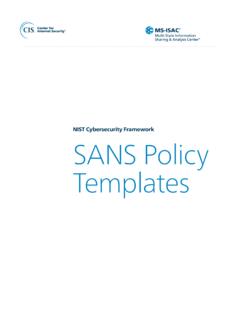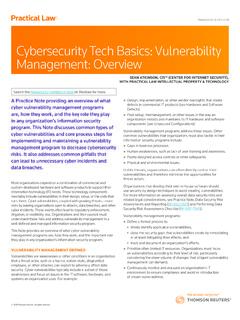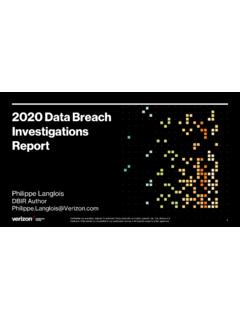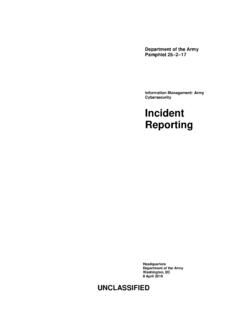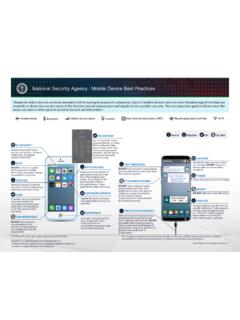Transcription of NIST Cybersecurity Framework Policy Template Guide
1 NIST Cybersecurity Framework Policy Template Guide Page 1. Contents Introduction 1. NIST Function: Identify 2. Identify: Asset Management ( ) 2. Identify: Risk Management Strategy ( ) 2. Identify: Supply Chain Risk Management ( ) 2. NIST Function: Protect 4. Protect: Identity Management and Access Control ( ) 4. Protect: Awareness and Training ( ) 4. Protect: Data security ( ) 4. Protect: Information Protection Processes and Procedures ( ) 5. Protect: Maintenance ( ) 6. Protect: Protective Technology ( ) 6. NIST Function: Detect 7. Detect: Anomalies and Events ( ) 7. Detect: security Continuous Monitoring ( ) 7. Detect: Detection Processes ( ) 7. NIST Function: Respond 8. Respond: Response Planning ( ) 8.
2 Respond: Communications ( ) 8. Respond: Analysis ( ) 9. Respond: Improvements ( ) 9. NIST Function: Recover 10. Recover: Recovery Planning ( ) 10. Recover: Improvements ( ) 10. Recover: Communications ( ) 10. Contents Page i Introduction The Multi-State Information Sharing & Analysis Center (MS-ISAC) is offering this Guide to participants of the Nationwide Cybersecurity Review (NCSR) and MS- ISAC members, as a resource to assist with the application and advancement of Cybersecurity policies. The Policy templates are provided courtesy of the State of New York and the State of California. The templates can be customized and used as an outline of an organizational Policy , with additional details to be added by the end user.
3 The NCSR question set represents the National Institute of Standards and Technology Cybersecurity Framework (NIST CSF). This Guide gives the correlation between 49 of the NIST CSF subcategories, and applicable Policy and standard templates. A NIST subcategory is represented by text, such as This represents the NIST function of Identify and the category of Asset Management. For additional information on services provided by the Multi-State Information Sharing & Analysis Center (MS-ISAC), please refer to the following page: https://. These Policy templates are also mapped to the resources MS-ISAC and CIS provide, open source resources, and free FedVTE. training: Disclaimer: These policies may not reference the most recent applicable NIST.
4 Revision, however may be used as a baseline Template for end users. These Policy templates are not to be used for profit or monetary gain by any organization. Introduction Page 1. NIST FUNCTION: Identify Identify: Asset Management ( ). Physical devices and systems within the organization are inventoried. Acceptable Use of Information Technology Resource Policy Access Control Policy Account Management/Access Control Standard Identification and Authentication Policy Information security Policy security Assessment and Authorization Policy security Awareness and Training Policy Software platforms and applications within the organization are inventoried. Acceptable Use of Information Technology Resource Policy Access Control Policy Account Management/Access Control Standard Identification and Authentication Policy Information security Policy security Assessment and Authorization Policy security Awareness and Training Policy External information systems are catalogued.
5 System and Communications Protection Policy Resources ( , hardware, devices , data, time, and software) are prioritized based on their classification, criticality, and business value). Information Classification Standard Information security Policy Cybersecurity roles and responsibilities for the entire workforces and third-party stakeholders ( suppliers, customers, partners) are established. Acceptable Use of Information Technology Resource Policy Information security Policy security Awareness and Training Policy Identify: Risk Management Strategy ( ). Risk management processes are established, managed, and agreed to by organizational stakeholders. Information security Policy Information security Risk Management Standard Risk Assessment Policy Identify: Supply Chain Risk Management ( ).
6 Suppliers and third-party partners of information systems, components, and services are identified, prioritized, and assessed using a cyber supply chain risk assessment process. Identification and Authentication Policy security Assessment and Authorization Policy Systems and Services Acquisition Policy NIST Function: Identify Page 2. Suppliers and third-party partners are routinely assessed using audits, test results, or other forms of evaluations to confirm they are meeting their contractual obligations. Identification and Authentication Policy security Assessment and Authorization Policy Systems and Services Acquisition Policy Response and recovery planning and testing are conducted with suppliers and third-party providers.
7 Computer security Threat Response Policy Cyber Incident Response Standard Incident Response Policy Systems and Services Acquisition Policy NIST Function: Identify Page 3. NIST FUNCTION: Protect Protect: Identity Management and Access Control ( ). Identities and credentials are issued, managed, verified, revoked, and audited for authorized devices , users and processes. Access Control Policy Account Management/Access Control Standard Authentication Tokens Standard Configuration Management Policy Identification and Authentication Policy Sanitization Secure Disposal Standard Secure Configuration Standard Secure System Development Life Cycle Standard Remote access is managed. Remote Access Standard Access permissions and authorizations are managed, incorporating the principles of least privilege and separation of duties.
8 Access Control Policy Account Management/Access Control Standard Authentication Tokens Standard Configuration Management Policy Identification and Authentication Policy Sanitization Secure Disposal Standard Secure Configuration Standard Secure System Development Life Cycle Standard Network integrity is protected ( , network segregation, network segmentation). Wireless Network security Standard Mobile device security System and Information Integrity Policy Protect: Awareness and Training ( ). All users are informed and trained. Acceptable Use of Information Technology Resources Policy Information security Policy Personnel security Policy Physical and Environmental Protection Policy security Awareness and Training Policy Protect: Data security ( ).
9 Data-at-rest is protected Computer security Threat Response Policy Cyber Incident Response Standard Encryption Standard Incident Response Policy Information security Policy Maintenance Policy Media Protection Policy Mobile device security Patch Management Standard NIST Function: Protect Page 4. Data-in-transit is protected. Computer security Threat Response Policy Cyber Incident Response Standard Encryption Standard Incident Response Policy Information security Policy Maintenance Policy Media Protection Policy Mobile device security Patch Management Standard Assets are formally managed throughout removal, transfers, and disposition. Access Control Policy Account Management/Access Control Standard Authentication Tokens Standard Configuration Management Policy Identification and Authentication Policy Sanitization Secure Disposal Standard Secure Configuration Standard Secure System Development Life Cycle Standard Integrity checking mechanisms are used to verify hardware integrity.
10 System and Information Integrity Policy Protect: Information Protection Processes and Procedures ( ). A baseline configuration of information technology/industrial control systems is created and maintained incorporating security principles ( concept of least functionality). Access Control Policy Account Management/Access Control Standard Authentication Tokens Standard Configuration Management Policy Identification and Authentication Policy Sanitization Secure Disposal Standard Secure Configuration Standard Secure System Development Life Cycle Standard Backups of information are conducted, maintained, and tested. Computer security Threat Response Policy Cyber Incident Response Standard Encryption Standard Incident Response Policy Information security Policy Maintenance Policy Media Protection Policy Mobile device security Patch Management Standard Data is destroyed according to Policy .

